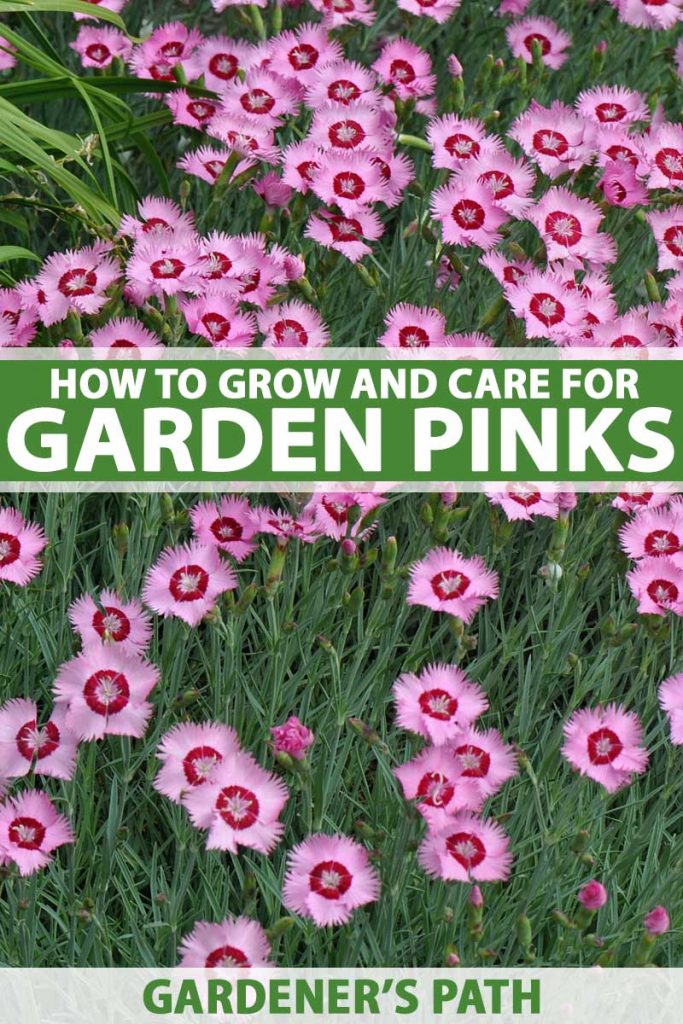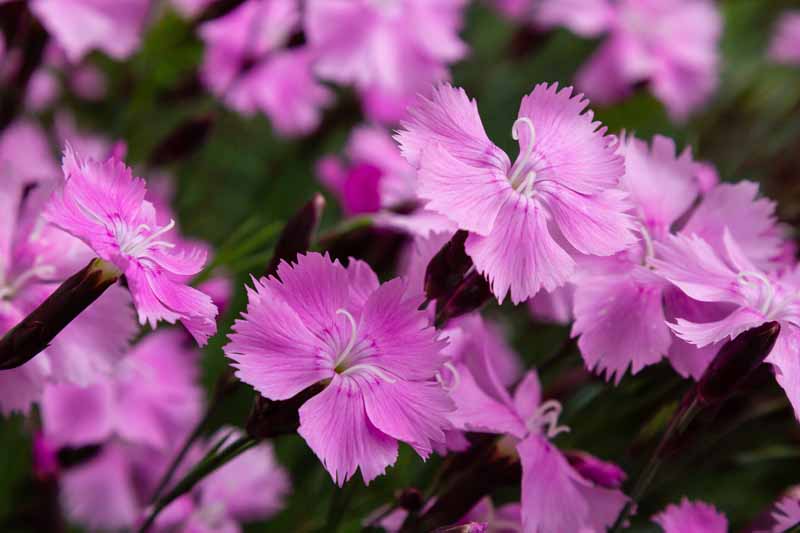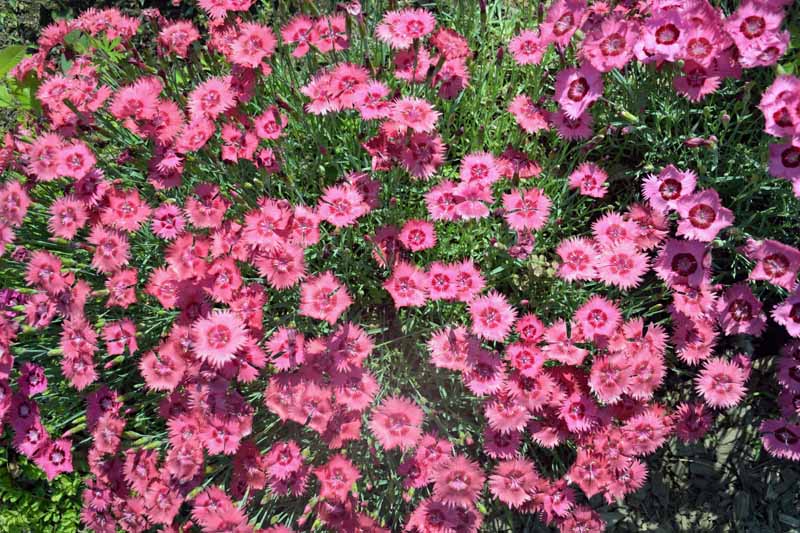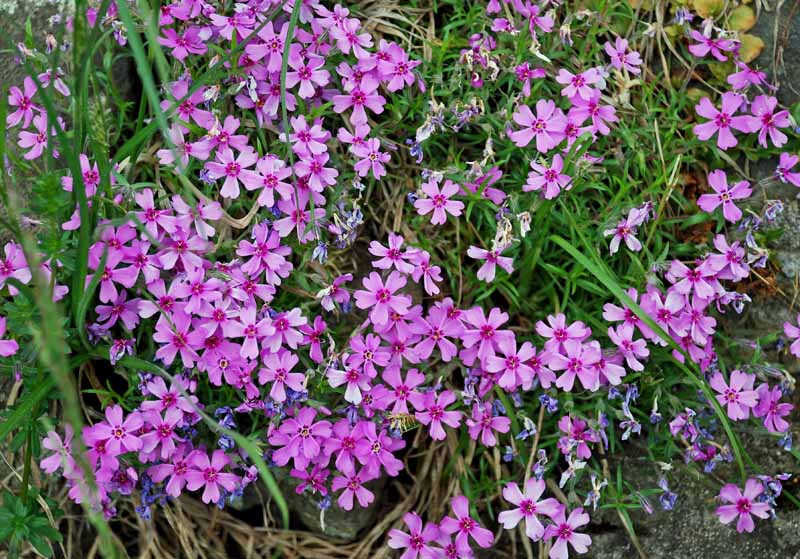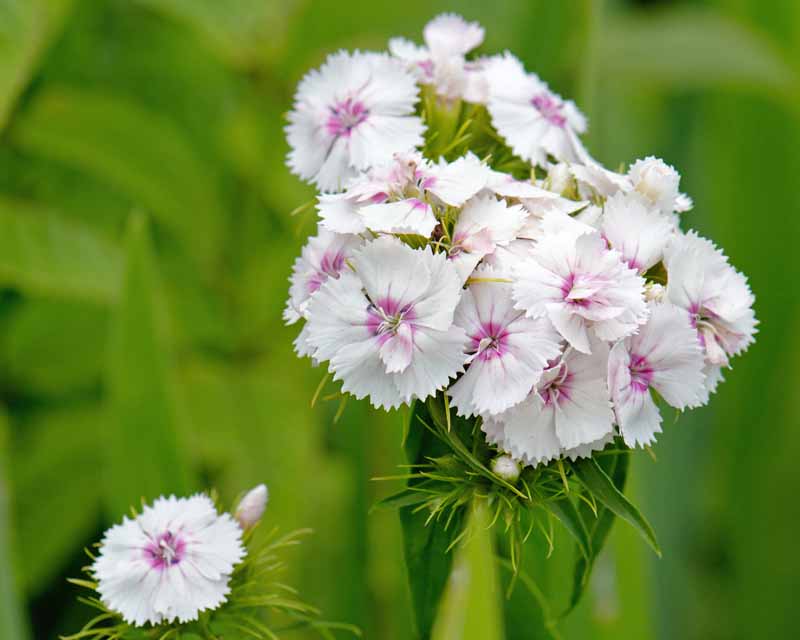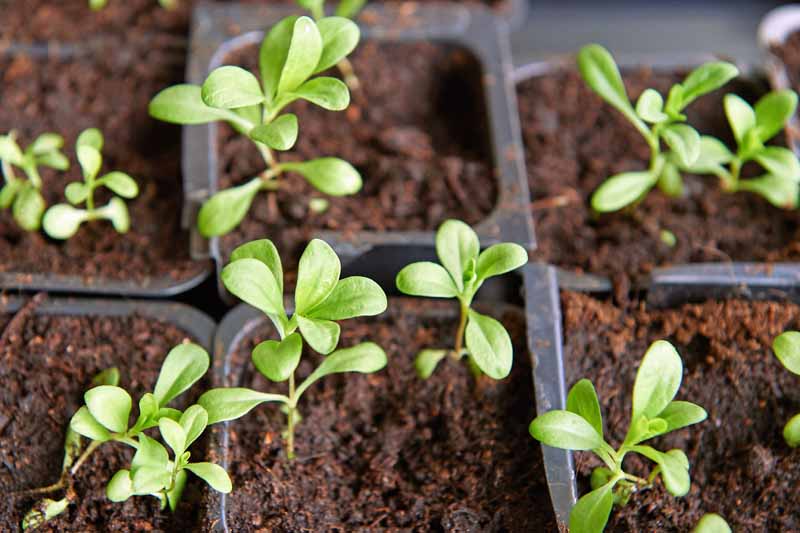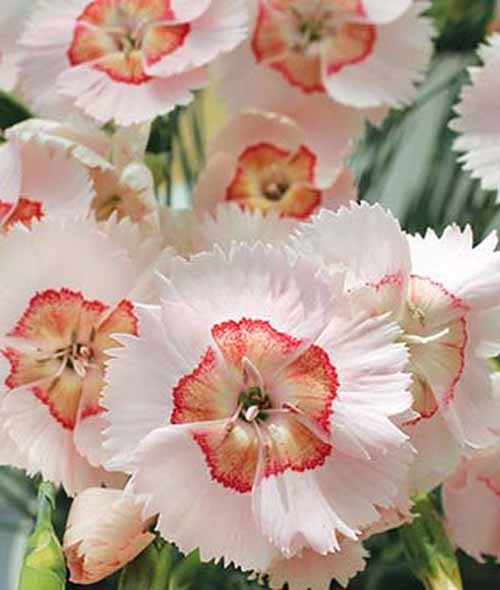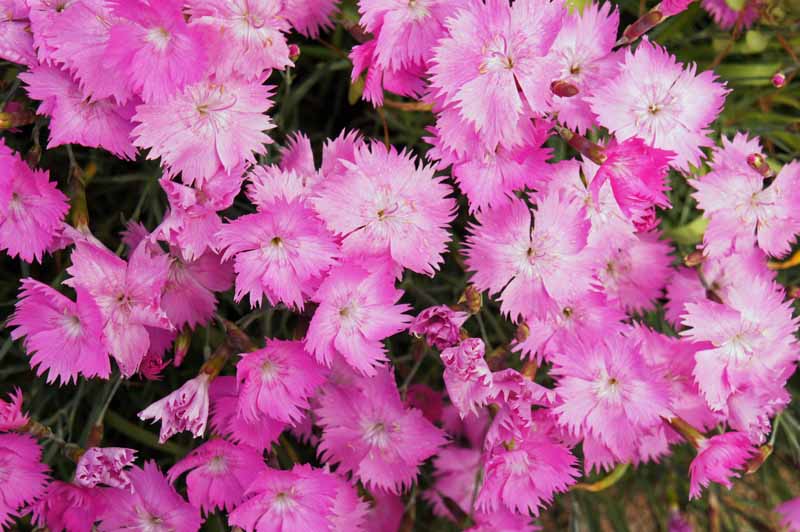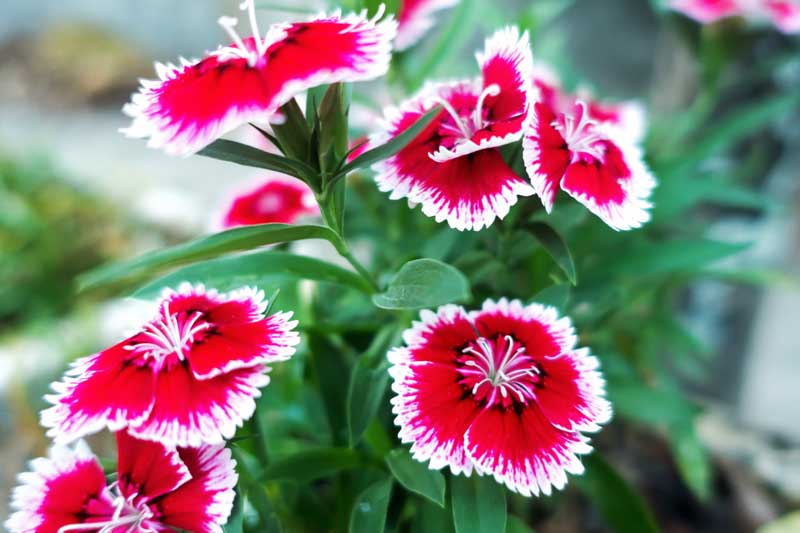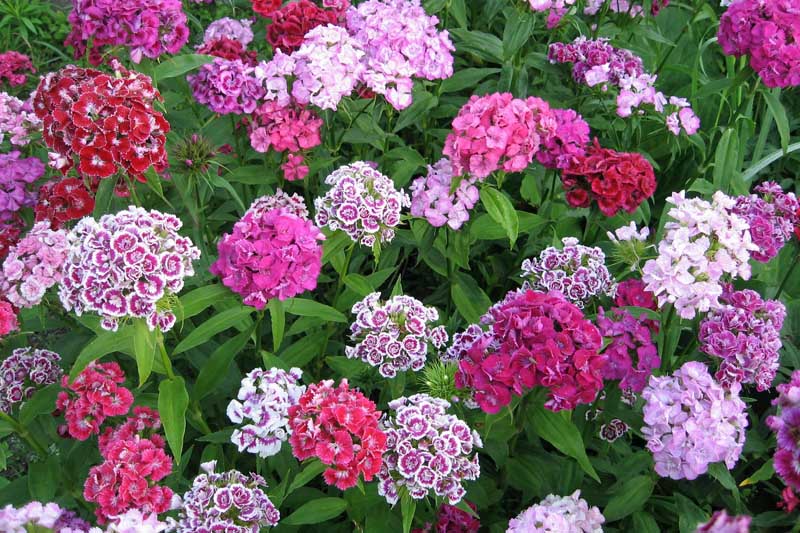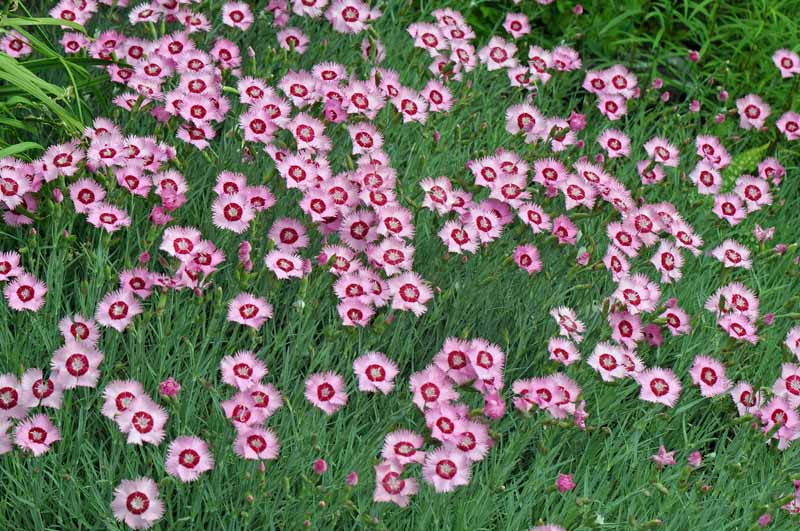With all the appeal of their larger cousin, the carnation, pinks are easily grown, have a full flowering season, and are among the best scented perennials in the garden. And they’re an absolute must-have if you enjoy bouquets of freshly cut flowers! We link to vendors to help you find relevant products. If you buy from one of our links, we may earn a commission.
Cultivation and History
Dianthus is a large genus in the family Caryophyllaceae, with over 300 species endemic to Asia, Europe, and Japan plus a North American alpine species. The genus name is derived from the Greek words dios (god) and anthos (flower), meaning “divine flower” or “flower of the gods.” Garden pinks or Dianthus plumarius is a species within the Dianthus genus and includes many cultivars that are grown in gardens and are suitable for landscape applications.
D. plumarius are also called common, cottage, Scotch, or wild pinks, and are native to central Europe, being introduced to the UK around the year 1100. A short-lived perennial evergreen, it has a mat-forming growth habit reaching 1- 2 feet tall and is hardy in Zones 4-9. Simple lancet leaves grow opposite one another on upright, branching stems in a subdued shade of glaucous gray green.
The pretty flowers grow in scapes of 3 to 5 buds and can be single, semi-double, or double petaled ranging in size from 1 to 2.5 inches – with the doubles typically offering the largest blooms. They come in tones of maroon, mauve, purple, pink, red, and white and have a seemingly infinite variety of color patterns, often with a striking eye of contrasting color.
Blooming from May to July, plumarius will re-bloom lightly after the first flush. Grown for their pretty, fringed flowers with a spicy fragrance of cloves, they’ve been cultivated for centuries. Numerous references to their popularity are found in European art works, tapestries, and the illuminated illustrations of Medieval texts and prayer books. And petals of D. plumarius were once added to wines and cordials to lend a spicy flavor – one of the oldest known cultivars is actually called ‘Sops in Wine’! Naming of the species is a little unclear. Some believe it comes from the German name for plants that bloomed at Pentecost called pfingsten. Others say it comes from the jagged petal edges, which look as though cut by pinking shears.
Regardless of the name origin, the color is named for the flower, and not the other way around. Until the eighteenth century, flowers in this shade were referred to as blush, carnation, flesh-colored, light or pale red, or rose, but never as “pink”.
Propagation
Garden pinks can be propagated by seed or by cuttings.
To grow from seed, start seeds indoors 6 to 8 weeks before the last frost in your region. Many cultivars are sterile and must be propagated by cuttings to ensure the same characteristics of the parent plant. This can be done with non-flowering cuttings taken in the summer.
How to Grow
Garden pinks grow best in a light, fluffy soil with a sandy, loamy texture and a neutral, or slightly limey, pH – but they don’t like to be in acidic soil. Add 4 to 6 inches of well-rotted manure or compost to enrich the soil before planting, and ensure the site is well-draining. Standing water in winter can be a problem and they need excellent drainage to prevent dieback. Add sharp sand to the planting site to improve drainage if needed. They require dry to medium moisture levels and full sun for a minimum of six hours per day – although they’ll appreciate some afternoon shade in very hot summer weather. And they can tolerate humidity, but ensure plants have proper air circulation to prevent fungal infections. Although perennial, they are short lived and will form bare patches in the center where the plant dies off. Plan on renewing them every 3 to 4 years. Because they’re so easy to propagate, starting a few cuttings each year is a good way to ensure your plants always survive the winter. D. plumarius also benefits from deadheading spent flowers which will encourage a second, lighter flush of blooms. In the garden, plants can be spaced 9 to 12 inches apart. In containers they can be closer, about 6 to 9 inches apart.
Growing Tips
Hardy in Zones 3-9, D. plumarius will appreciate a thick mulch in winter to protect it from cold and harsh winds. In colder regions, they can easily be grown from seed as an annual if started early indoors. Pinks have a sweet fragrance of cloves and make a wonderful, long-lasting cut flower – be sure to plant plenty to cut for indoor arrangements. Old-fashioned varieties will self-seed readily in optimum conditions – leave some seedheads in place if so desired. Replace every 3 to 4 years to keep plants looking vibrant. Plants are deer resistant.
Pruning and Maintenance
Garden pinks are easy to care for and will respond well to just a little TLC. Prompt deadheading of spent flowers will extend the bloom period and encourage new buds. For large plantings, shear the plants after blooming. This prevents self-seeding, trims the stems and foliage, and encourages a second, lighter flush of flowers. In regions with cold winters, provide a 4 to 6-inch layer of dry mulch such as hay, shredded leaves, or straw. In spring, once new foliage begins to emerge but before the flower buds, remove any mulch or winter debris. Remove any dead spots that developed over winter, then top and side dress plants with organic material such as aged compost or manure. Fluff the material before top dressing and rake material gently down to the roots.
Close Relations
There are other species of dianthus often referred to as garden pinks, due to their many similarities. Dianthus plumarius ‘Sweetness’ Seeds Mats of foliage grow 4 to 6 inches high with flowers stems only 6 inches tall. Easy to grow from seed, try these fragrant lovelies are well-suited to beds, borders, containers, and rockeries. ‘White Lace’ is a long-lived, highly fragrant plumarius with striking, pure white, single-petal blooms and cool, glaucous foliage. It mounds to a height of 6 inches with 10 to 12-inch flower stems and a 12-inch spread. Dianthus plumarius ‘White Lace’ Seeds Blooming heavily in April to July, it reblooms lightly until frost if sheared after the first flowering. Deer and rabbit resistant and drought tolerant, ‘White Lace’ is attractive to butterflies and blooms the first year. ‘Georgia Peach Pie’ is a plumarius hybrid that features large, pale-peach flowers with a saucy, apricot-coral eye and a delicious perfume. It blooms from May to July, with sporadic flowers until September after deadheading the first set of flowers.
‘Georgia Peach Pie’ Live Plants Foliage forms a compact, 6 to 8-inch cushion with a spread of 10 to 12 inches and tall flower stems 10 to 12 inches high – perfect for the cutting garden! And beds, borders, or rock gardens. Bred for outstanding cold and drought tolerance, it’s also deer resistant. But bees and butterflies love the large, fragrant flowers. Order handsome ‘Georgia Peach Pie’ plants online from Burpee. ‘Sonata’ mixed are double-petaled plumarius with a sweet scent of cloves in shades of pink, red, rose, and white, some with distinctive marked eyes. This mat-forming perennial has gray green foliage growing 4 to 6 inches tall with 12-flower stalks and a 12-inch spread. Dianthus ‘Sonata’ Mix Flower Seeds They flower from May to July with lighter blooms until September if cut back or sheared after the first flush of flowers. Easy to establish from seed, ‘Sonata’ makes an excellent flowering ground cover. The most common of these are:
Cheddar Pinks, D. gratianopolitanus China Pinks, D. chinensis Sweet William, D. barbatus
Cheddar Pinks, D. gratianopolitanus
D. gratianopolitanus, or Cheddar pinks, are native to western and central Europe, and have a tufted, mounding form with small, fringed flowers in mauve, pink, and rose with a rich, spicy perfume. They flower abundantly in spring and early summer with a second, lighter, bloom after the first flush if spent flowers are deadheaded. Growing 5 to 6 inches tall with a spread of 10 to 12 inches, Cheddars are hardy in Zones 4-8. Find tips on growing cheddar pinks here.
China Pinks, D. chinensis
D. chinensis are commonly called China or rainbow pinks, and are native to east Asia including China, Korea, Mongolia, and southeast Russia. Extensively hybridized, they’re found in most garden shops. Plants and can grow as tall as 30 inches, although many cultivars are bred for compact or mid-sized growth with a mature height of 6 to 12 and 12 to 18 inches. They feature fragrant flower clusters in shades of mauve, pink, red, and white with numerous bicolors and pattern variety. Blooming in summer, many will repeat with a vigorous pruning after the first flush of flowers. They prefer cool summers and dislike in heat and humidity. Grown as a biennial or short-lived perennial, they’re hardy in Zones 6-9. Read more about growing China pink flowers here.
Sweet William, D. barbatus
Commonly called sweet William, D. barbatus is another popular garden species. They can grow as tall as 36 inches, but typical growth is 12 to 24 inches with many cultivars bred as dwarf plants 6 to 8 inches tall. They feature full, terminal clusters of small single, semi, or double flowers 3 to 5 inches wide in vivid, patterned shades of bubblegum, mauve, red, and white plus bicolors and often with a contrasting eye. Old fashioned varieties are fragrant, but many of the newer cultivars are scent-free. Winter hardy in Zones 3-9, sweet williams are grown as a biennial or short-lived perennial that re-seeds readily, remaining vibrant in the garden for years. When grown from seed, they’ll bloom the first year if started early indoors. Read more about grow sweet william flowers here.
Managing Pests and Problems
In areas with warm, humid summers or prolonged wet spells, leaf spot bacteria, Alternaria solani and Septoria lycopersici, can cause blight – brown, gray, tan, or yellow spots that first appear on foliage. Spider mites and aphids like to suck sap from dianthus and can be controlled with a good blast from the garden hose. Make sure to spray the underside of leaves to get all of them. Or, an insecticidal soap will dispatch most insects, as will a spray of neem oil. Adding ladybugs to the garden is another good way of controlling the smaller pest insects. Crown rot can also be a problem that shows up as wilt and dieback, and prevention is the best solution. Ensure your plants have excellent drainage, particularly in winter when standing water can cause damage. Thankfully, slugs, snails, and deer all find dianthus distasteful!
Quick Reference Growing Chart
Best Uses in the Garden
Compact or dwarf plants with a low-growing habit are best suited to the front of beds or borders, containers, edging, rockeries, and windowboxes. And they make a cheery, mat-forming ground cover in sunny spots.
Mid-sized and tall plants are well-suited to the middle of beds and borders, alongside paths, and close to terraces, patios, and open windows where their lovely perfume can be enjoyed. And, they’re a natural in the cutting garden of course! Dianthus are an excellent, long-lasting cut flower – so plant plenty of the mid and tall-stemmed varieties to bring inside for arrangements.
Tickled Pink
Now that you’ve been tickled pink, think you might give these old-time lovelies a try?
Compact, mid, or full-sized, there’s a cultivar waiting to add color and fragrance to your garden – and remember to plant some for cutting!
How to Grow and Care for Dianthus Flowers How to Grow and Care for Alpine Pinks How to Grow and Care for Firewitch Dianthus
© Ask the Experts, LLC. ALL RIGHTS RESERVED. See our TOS for more details. Product photos via Hazzard Seeds, Burpee, and Astor Farms. Uncredited photos: Shutterstock.
